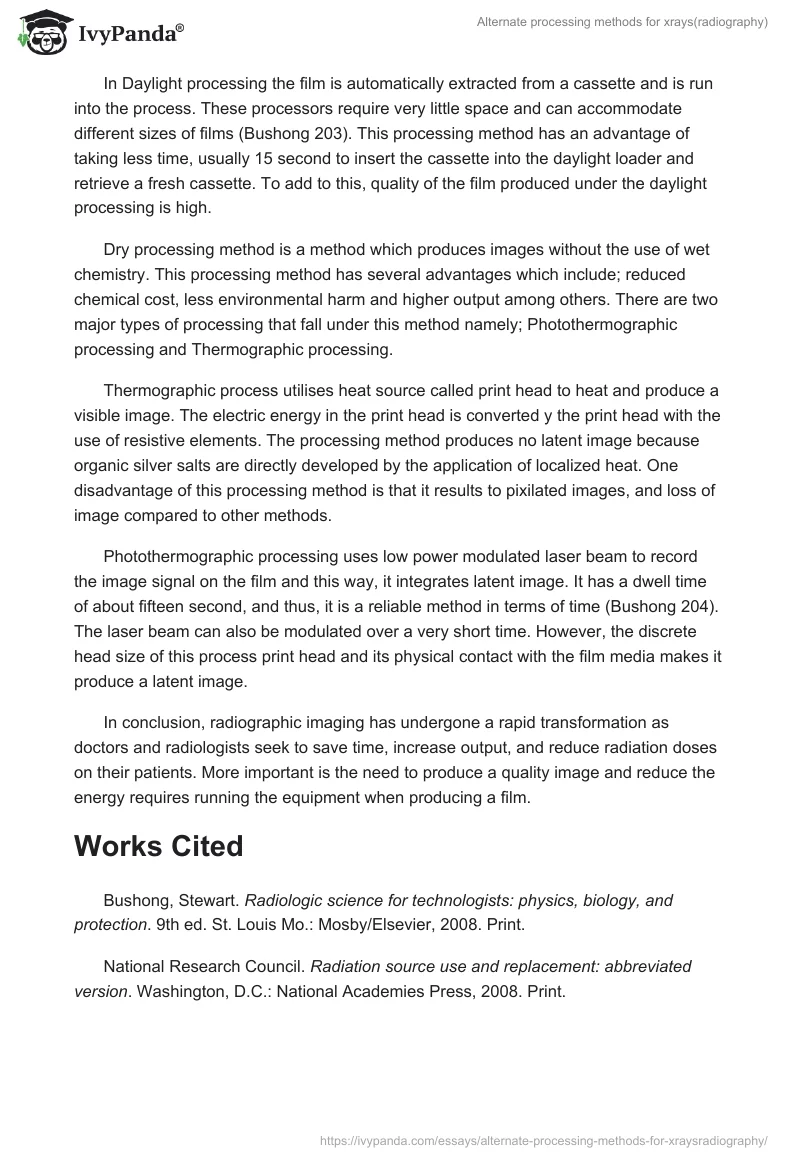Radiographic film processing involves a process where an exposed film is subjected to specific treatment to enable clear visualization of exposed parts to enable identification of abnormalities under scrutiny for an effective and conclusive diagnosis. It is the production of images on a radioactive sensitive material using non-destructive semiconductor failure technique of analysis.
This method utilized the principle of difference in absorption capacity for various body parts, where more dense regions (bones) absorbs majority of exposed light as opposed to less dense regions (tissues and voids), the former will be clearly demarcated and thus abnormalities easily identified (National Research Council 135).
These methods include; Rapid processing, extended processing, Dry processing (Thermographic processing and Photothermographic processing), and daylight processing among others. This paper attempts to evaluate the alternate processing methods for radiography, their pros and cons, as well as the way they work.
Rapid processing method considers the time taken to produce a single image. This processing method takes only thirty minutes to produce a radiographic image without interfering with the quality of image. This is an improvement from the ninety minutes taken by the standard processing methods.
This becomes a beneficial factor for some emergency cases like angiography, surgery and other special procedures that require fast production of radiographic images to be used by physicians in the diagnosis, and treatment of patients. However, the processing method is very expensive, and the radiation dose is very high compared to standard processing methods (Bushong 203).
Extended processing radiography is particularly useful in mammography considering its extended processing, greater image contrast and lower radiation dose. However the processing method takes long to drop. Daylight processing has come to save radiology on the need to depend on the dark room for the process.
In Daylight processing the film is automatically extracted from a cassette and is run into the process. These processors require very little space and can accommodate different sizes of films (Bushong 203). This processing method has an advantage of taking less time, usually 15 second to insert the cassette into the daylight loader and retrieve a fresh cassette. To add to this, quality of the film produced under the daylight processing is high.
Dry processing method is a method which produces images without the use of wet chemistry. This processing method has several advantages which include; reduced chemical cost, less environmental harm and higher output among others. There are two major types of processing that fall under this method namely; Photothermographic processing and Thermographic processing.
Thermographic process utilises heat source called print head to heat and produce a visible image. The electric energy in the print head is converted y the print head with the use of resistive elements. The processing method produces no latent image because organic silver salts are directly developed by the application of localized heat. One disadvantage of this processing method is that it results to pixilated images, and loss of image compared to other methods.
Photothermographic processing uses low power modulated laser beam to record the image signal on the film and this way, it integrates latent image. It has a dwell time of about fifteen second, and thus, it is a reliable method in terms of time (Bushong 204). The laser beam can also be modulated over a very short time. However, the discrete head size of this process print head and its physical contact with the film media makes it produce a latent image.
In conclusion, radiographic imaging has undergone a rapid transformation as doctors and radiologists seek to save time, increase output, and reduce radiation doses on their patients. More important is the need to produce a quality image and reduce the energy requires running the equipment when producing a film.
Works Cited
Bushong, Stewart. Radiologic science for technologists: physics, biology, and protection. 9th ed. St. Louis Mo.: Mosby/Elsevier, 2008. Print.
National Research Council. Radiation source use and replacement: abbreviated version. Washington, D.C.: National Academies Press, 2008. Print.


